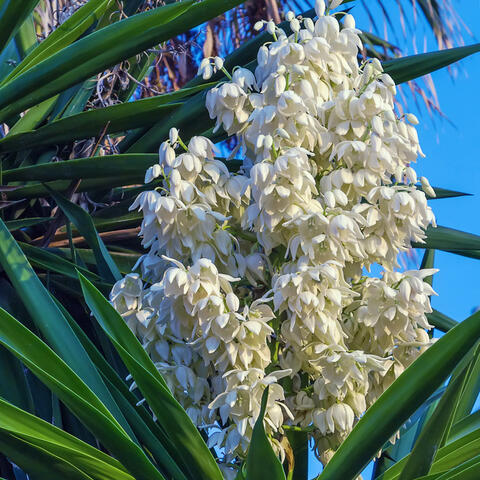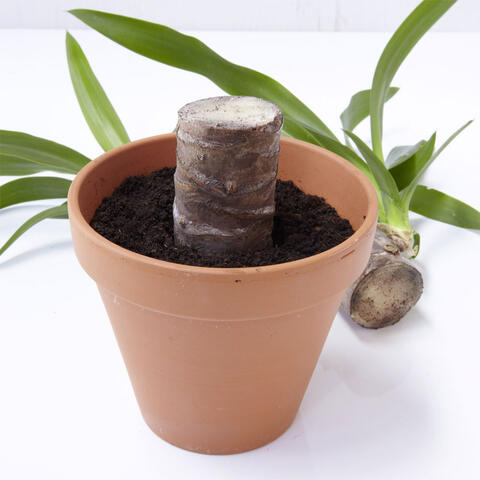Yucca palms, Giant palm lily
Yucca palms are a decorative and easy-to-care for indoor plant. The giant palm lilies are perfect green plants for the home and office as they are easy-to-care for and have a fine growth. Here, you will get to know about the palm tree, which isn’t exactly a palm tree.
Factsheet
- Growth height (from)
- from 200 cm to 300 cm
- Growth characteristics
-
- bizarre
- upright
- overhanging
- multi-trunked
- Flower color
-
- white
- Flowering time (month)
-
- August to September
- Flower shape
-
- Bells
- panicles
- Flower characteristics
-
- unfilled
- hermaphroditic
- Leaf color
-
- green
- page format
-
- sword-shaped
- pointed
- Sheet properties
-
- evergreen
- Rosette
- Fruit shape
-
- Capsule
- Light
-
- sunny to scattered light
- Soil type
-
- sandy to loamy
- Soil Moisture
-
- moderately dry to fresh
- ph value
-
- neutral to weakly acidic
- Lime compatibility
-
- lime-tolerant
- Nutrient requirements
-
- moderately nutritious
- Humus
-
- rich in humus
- Decorative or utility value
-
- Leaf ornaments
- picturesque growth
- Toxicity
-
- non-toxic
- Winter Hardness
-
- frost-sensitive
- Climate zones according to USDA
-
- 10
- Use
-
- Interior greening
- Planters
- Winter garden
- cold house
- Garden style
-
- Pot garden
The yucca plant is actually called the giant palm lily. Contrary to what its name suggests, it is not a real palm tree but actually an asparagus plant (Asparagaceae). The name "palm lily" stems from the resemblance of the leafy crown with that of a palm tree and its lily shaped flowers. The oldest ancestors of the yucca palm plants were found on the earth 20 million years ago. Nowadays, you will find 40 to 50 different species of the yucca genus. In this country, "Yucca palm" primarily means the giant palm lily (Yucca elephantipes).
Palm lilies are popular houseplants in southern Europe, and can be found even in parks and gardens. Its original home is in the high altitudes of Mexico and Central America, where it grows at an altitude of 6561.68 feet. The yucca palm is slow-growing and undemanding when it comes to care; making it an ideal houseplant for beginners. Apart from the giant palm lilies, the Adam’s needle and thread (Yucca filamentosa) as well as the Beaked yucca (Yucca rostrata) are quite popular here as garden shrubs. In milder regions, the Spanish dagger (Yucca gloriosa) can be planted in the garden. It is often planted in rock gardens and is sufficiently frost hardy to be overwintered outdoors.

The yucca palm plant forms single to several firm and fibrous, gray trunks that usually grow vertically upwards. The stems turn brown with age and become increasingly hollow on the inside. In its dry and hot home, the giant palm lily can grow up to 29.52 feet high. As a container plant, the Yucca elephantipes reaches heights of up to 9.84 feet.
Typical of the giant palm lily are the tufted, sword-shaped leaves with a pointed spike at the end, arranged radially around the end of the trunk and the side shoots. For a yucca they are relatively soft, dark green with slightly serrated leaf margins. The older, up to 3.28 feet long and 3.14 inches wide yucca leaves usually hang elegantly downwards. The inner, younger leaves, however, stick out upwards. At the lower end of the leaf crown, the leaves gradually dry up and detach from the trunk.
As potted plants, yucca palms only bloom in optimal conditions, for example in a bright conservatory. The flowers appear at the earliest after ten years between August and September. The pure white bell-blossoms standing in panicles are a magnificent sight and resemble lilies of the valley. Small potted plants on the windowsill usually do not bloom. In the wild, pollination takes place by yucca moths (prodoxidae). The flowers and the stem tips of the giant palm lily are edible, but should be consumed with caution as they contain saponins.

The giant palm lily is dependent on the yucca moth to pollinate its flowers. In its central American native region, the yucca palm develops seed capsules after pollination, in which several small black or gray seeds can be found.
A giant palm lily is the ideal houseplant for bright rooms and corners. Even placing the plant in a window with direct sunlight, works well . In summer, around May to October, it loves to pick up some fresh air from the patio or the balcony. Place your Yucca palm there in a bright spot with full sunlight. If you want to keep the palm lily in the room, place it near an airy spot all year long. Yucca elephantipes is not entirely winter-hardy, however, it can tolerate frost up to 17.6 degree Fahrenheit. Therefore, you can plant it in the open in very mild areas with good winter protection. In areas with severe frosts, the Yucca palms should be planted in pots and kept in the house during the cold months. Also, keep the Yucca palm in a bright location in winter. Then a cool room temperature of 41 to 44.7 degrees Fahrenheit suffices.
The potted plant needs houseplant soil or potting soil as a substrate. Therefore, mix the soil for Yucca palms with large sand or clay granulate. Cactus soil is also suitable for planting the giant palm lily. Important: Waterlogging in the planting soil of the giant palm lily should be avoided, the plant does not tolerate dampness well. Choose a substrate that is permeable and maintains its structure.

Bear in mind the following points while watering the Yucca palm: The plant comes from very hot and dry region and therefore requires less water in the pot. Water the Yucca elephantipes occasionally, but thoroughly. In the growing season from spring to fall, watering once a week is sufficient. In winter (if the palm lily is placed in a cold location) it is only watered thoroughly about once a month. At no point in time should the Yucca palms be too wet, as it stores water in its trunk. Before watering, ensure that the soil layer is fairly dry. Extra water in the planter or coaster must be discarded. Occasionally spray with rain water or water that has minimal lime content; this refreshes the plant and prevents pest infestation.
From May to September, every two weeks, you can add some green plant fertilizer to the water. During the dormant phase in the winter months, the Yucca elephantipes should not be fertilized.

If the yucca is still in growth phase, it can be repotted every two to three years. In spring, plant Yucca elehantipes in a slightly larger planter with nutrient-rich, permeable soil and open water drainage. In good growing conditions, however, palm lilies usually grow faster than what the owner would approve of. In this case, repotting of healthy plants can be done even every four to five years. The yucca palms dislike waterlogging — use a pot with an open drain! Repotting in the old pot is also possible. In this case, you only need to renew the substrate.
Since yucca palms do not branch vigorously, it makes sense to cut back long shoots of the plant occasionally in spring. Below the cut surface, the houseplants sprouts several new shoots in good lighting conditions and gets bushier again. You can also detach the entire crown of the palm lily. Below the cut surface, the old plant sprouts new branches.

If you cut and propagate a yucca, you hit two birds with one stone. Because the leaf heads cut off when pruning the plants are terminal cuttings that can easily grow roots in the ground or in a darkened water glass. Also, around 4.72 inches long bare stem sections can grow as a new plant, if its original direction of growth is maintained while placing it in the soil. A bit of patience is required at times, since the stem cuttings of the Yucca elephantipes might take a few weeks, even several months, to sprout new leaves. The cut surface on the parent plant must be sealed with grafting wax, so that the fibrous stem doesn’t dry up further.
If the air is too dry, the giant palm lily can also get infested by spider mites or scale insects, just the way other houseplants are affected. You can often see the woolly webs of mealybugs on the yucca palm. If the Yucca elephantipes leaves turn yellow, a location might be too dark.

